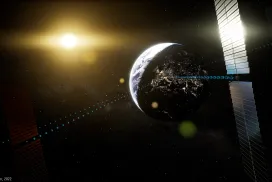Do you think about space, when you turn on your light at home? You should – as space is a key enabler, when it comes to secure and efficient energy supply.
How does the space sector help energy supply on Earth?
Basically, in two ways. First, through technological know-how in solar energy, hydrogen or energy efficiency. Secondly, through essential data from satellites in space – with our products as mission-critical elements for many of these satellites.
Solar cells
Solar cells – now widely used on Earth – experienced their breakthrough only through space. For hydrogen, promising as a future propulsion for vehicles or aircraft, the space sector can contribute its decades of experience with liquid hydrogen in rockets. Another area of space expertise is energy efficiency. ESA vividly explains why: “In space we cannot afford to lose even a watt of energy. Space engineers are probably the most energy-conscious scientists on Earth.” The space sector can contribute methods to cut heat loss, reducing energy needs, or to remove waste heat – such as keeping batteries cool to increase their effectiveness.
Keeping power grids stable
Every day satellites provide essential data that keep our energy supply running, make it safer and more efficient. Space data help synchronizing our increasingly decentralized energy supply (more and more wind and solar power plants in remote locations). Without the time signals from navigation satellites, entire power grids would become unstable – with outages or blackouts as a result.
Maximizing energy yield
Space data are also indispensable for maximum energy yield. Satellite data help to find the best spot for the construction of wind or solar power plants. Once the wind and solar power plants are built, satellite data help maximize the daily energy yield, e.g. through “sunshine maps” from the European weather satellites Meteosat.
Efficient transport
Data from navigation satellites like GPS or Galileo enable people and goods to get from A to B as efficiently as possible. Teleconferencing, made possible in part by telecommunications satellites, reduces unnecessary travel and thus saves energy. Energy is also saved by avoiding leakages. Satellites provide e.g. data on leaks in gas pipelines. Space weather forecasts are crucial in safeguarding oil pipelines from harmful power surges or current-driven corrosion.
Solar power from space
Space could also provide a game-changing source of our future energy supply: solar power produced in space and beamed to Earth by means of microwaves. The advantage: In space, the sun shines for 24 hours and the sunlight is much more intense than on Earth. With this, the space sector would once again be a key enabler for the world’s energy supply.




